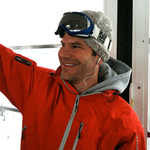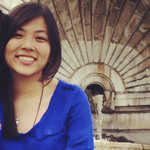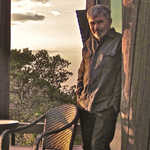I looked up from my phone long enough to see the doors slip shut at Howard Beach. I was a bit dazed, having just accidentally bought an antique map of Borneo.
Ever since the A-Train emerged from underground after the Grant Ave stop, I’d been glued to an auctioneer app on my phone, watching a huge estate auction in San Francisco slowly advance, lot by lot. The book lots I was interested were still far away, but I’d been hypnotized all day by the auction, the long slow procession of things. An item appears on the screen, bids are made, then the bidding closes and the item disappears. Instantly replaced by a new item.
When the map of Borneo appeared on my screen, I tried to swipe across the image, the picture of the map, but instead I hit the “Bid” button. No one else bid, not online or on the floor in California. I’d bought Borneo.
After the A-Train leaves the Howard Beach stop, it begins to cross a long, straight causeway across Jamaica Bay. A long, long causeway. The train feels like it hovers just above the flat water. And way over there, on the other side of all that water, is the airport. JFK.
At London Heathrow, long moving sidewalks connect the jetways to the terminals. Every fifty feet or so a sign overhead reminds passengers to “face direction of travel” so as to avoid falling off the conveyor belt.
Standing on the A-Train, traveling across a straight line over the water, I remembered the cryptic message from Heathrow. But instead of moving towards a terminal, I’d missed my stop and was moving away from the travel. But from this vantage point I could see the intended destination, the vast sprawl of JFK. Tiny planes taxied around the tarmac before angling up at 90 degrees into the sky. The ride between Howard Beach and the next stop at Broad Channel is a long stretch of track; I watched several planes take off. Curiously, nothing landed.
When the train finally arrived across Jamaica Bay at Broad Channel, I got off, crossed the tracks, and caught the next train back to Howard Beach and JFK. I watched more planes take off. Again, nothing landed. I thought about Borneo. My father spent the first year of his life on Borneo after his parents fled Jakarta and the revolution. So buying the map was not entirely a mistake, it was more rhetorical question. Someone in a California auction house said “Borneo” and I rose my hand.
At Howard Beach a second time around I transferred to the Airtrain. I like to stand at the front of the train and watch the track disappear as it speeds towards the terminals. In most trains, and most planes, one must be the driver or the pilot to stand in the direction of travel. The passengers sit behind and look to the side, seeing the world pass without seeing what is directly ahead. The Airtrain is an exception to this rule because there is no driver, it is controlled remotely by a computer. Any passenger can just stand in the front of the train and face forward.
In 1958 my father, along with his parents and three brothers, passed through JFK. Though of course it was not called JFK yet; before Kennedy was president, before Kennedy was dead of a bullet shot from a rifle in Texas, the airport was known as Idlewild. But plans were already in place to rename the growing airport. TWA, Pan Am, Braniff, American, Northwest and United where all constructing new buildings. The airport was to be renamed Terminal City.
Of the terminals built in the early 1960’s, only Saarinen’s TWA terminal remains intact. Jet Blue owns it now. The building is empty, unused, far too small for today’s air travel. But the building is landmarked, so it has been spared. The TWA terminal is, was, a metaphorical building, an attempt to depict flight with the brutalist pallet of concrete and glass.
The Pan Am “Worldport” terminal took a different approach; their terminal was designed to resemble a giant drive in hamburger stand circa 1958, but with jet planes instead of finned Chevys. It was pure kitsch, Googie, an awkward sort of atomic age gigantism that always made me smile. But unlike the TWA terminal, the Pan Am building was mostly unloved. The last time I went inside the ceiling was falling apart. Big billowing tarps were hung from the rafters to catch the falling bits. Birds flew around inside; though still in use it felt like an abandoned ruin.
Having finally arrived at the airport, I saw what remained of Pan Am terminal. Four pyramids of rubble. The arrangement seemed ritualistic, an act of magic, a performance of disappearance.
I thought about Borneo.
Filed Under
Other moments in New York
-
Espressoing
in New York, United States -
A few more days
in New York, United States -
Goodbye
A final Hi meeting
in New York, United States -
meditation, Creativity
The local neighborhood bar has a quiet time between six and nine. It is a place that specializes in coffee, beer and seasonal menus. There is just enough of each for a satisfying snack and effective buzz. After the time when the laptop lids close and before the social gatherings start -- there is a sort of twilight*. Often this time is a fugitive ground rife with creative inspiration and meditative work -- of the kind that results in personal reward.*twilight may refer to civil, nautical or astronomical variety depending on your social or terrestrial condition
in New York, United States -
Web, development
A man positions his mouse on the edge of his browser window. He clicks, holds and drags the viewport first left then right. The content of a video game promo micro site responds and adapts to the available space. To the man, this is more delightful than the game itself.
in New York, United States -
subway, music
A man laboriously moves his piano down three levels onto the subway platform. Classic vocals and strided chords -- he played so well I swore he was blind. Oblivious to the heat on that August stage, he was most in touch with his audience -- whom he elevated with his music.
in New York, United States -
Feminism
A woman should do exactly as she pleases no matter what a man may think.
in New York, United States -
Travel
As the Dalai Lama once said, "It is a time when there is much in the window, but nothing in the room."
in New York, United States -
stars, Grandma, Love
"No one understands me," she said. Her grandmother was silent for a minute. It seemed she was searching for an answer in the star speckled sky. "But no one understands anyone in this world, darling. We are all unique. It is what gives us a sense of wonder."
in New York, United States






